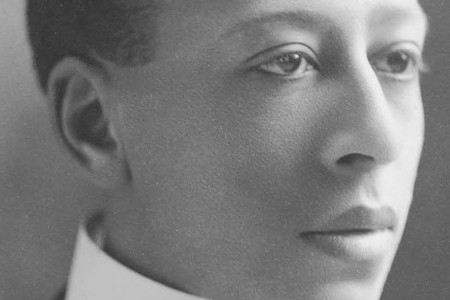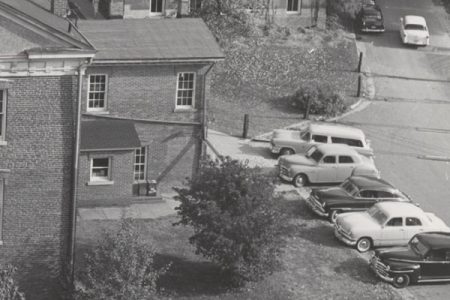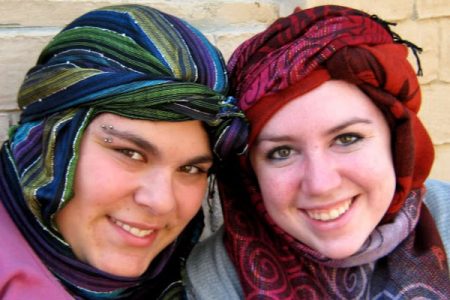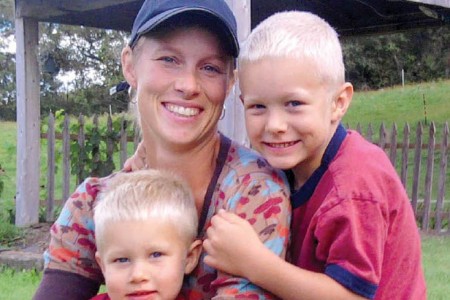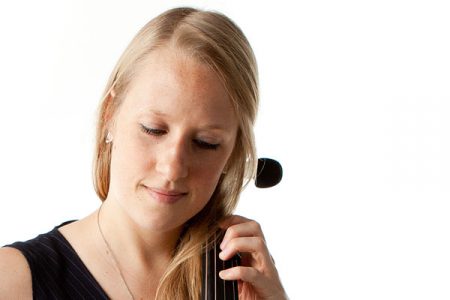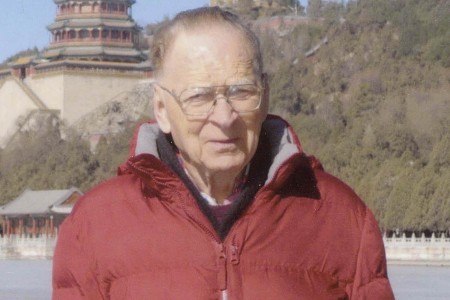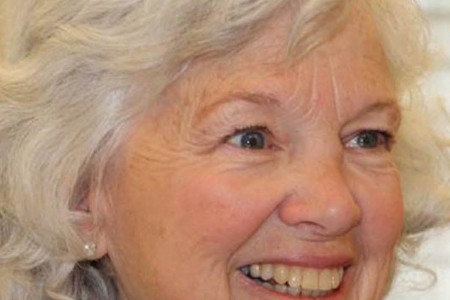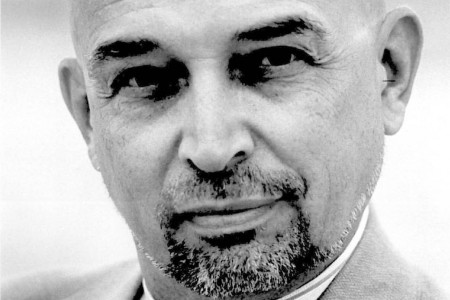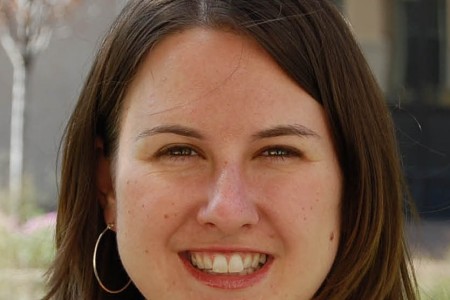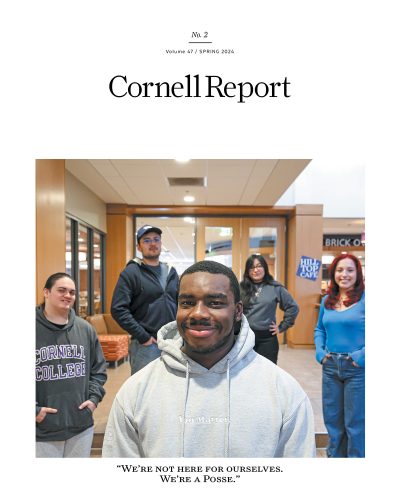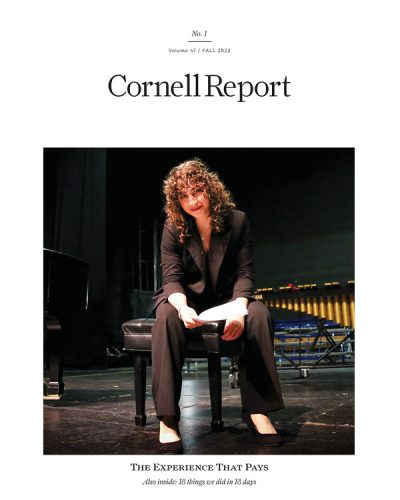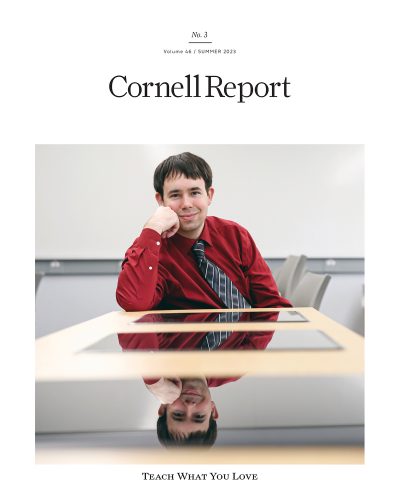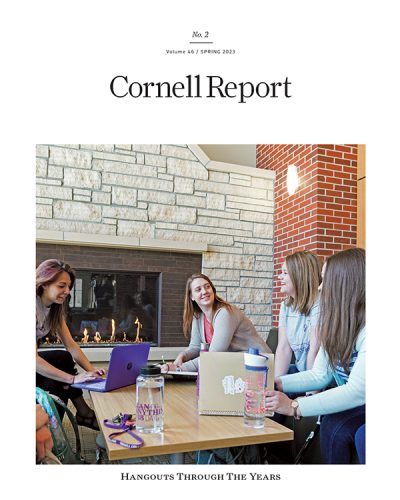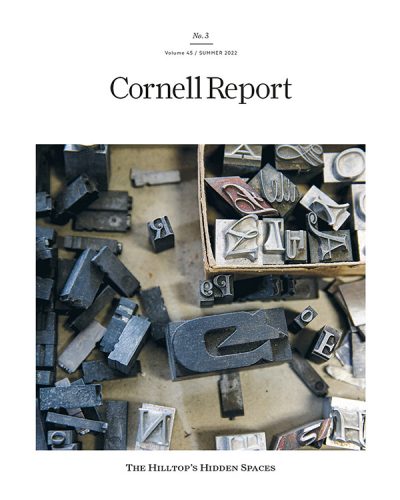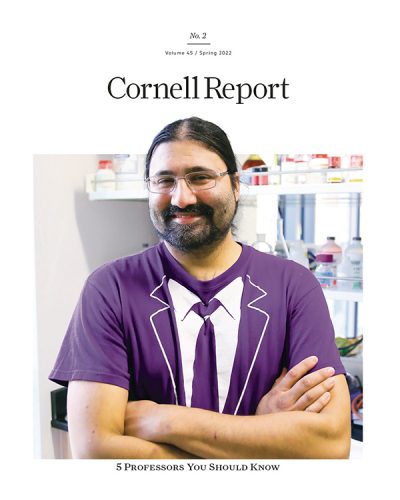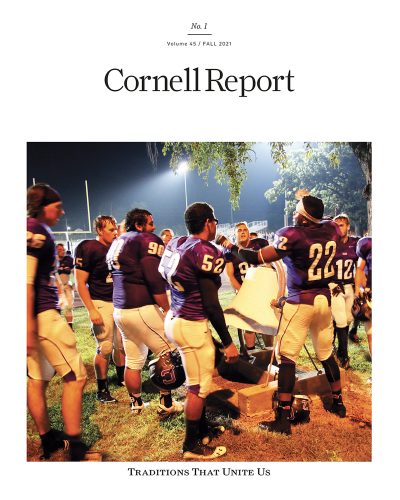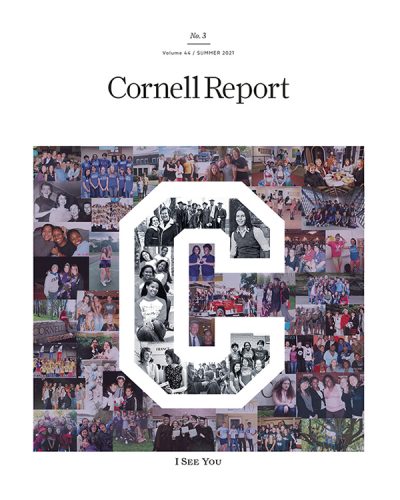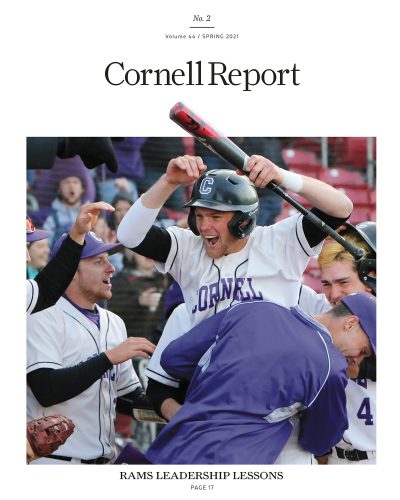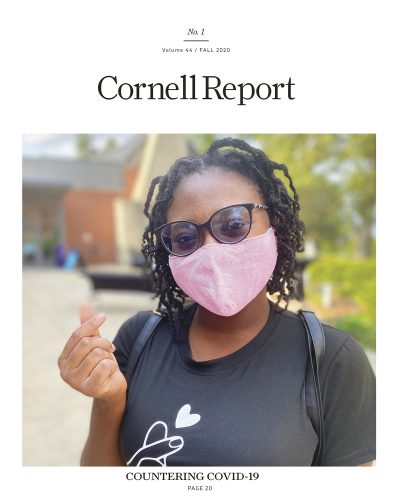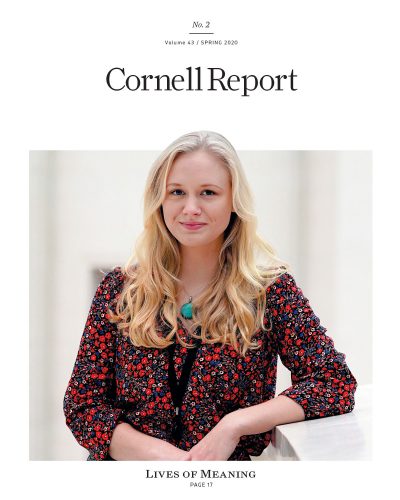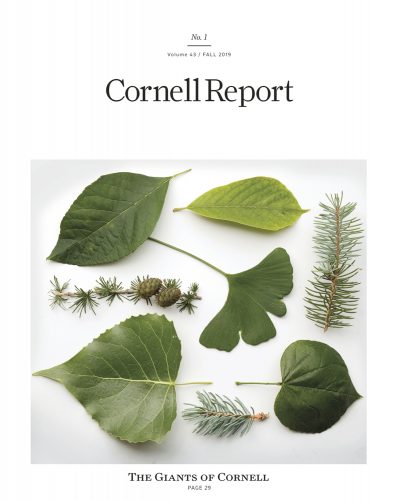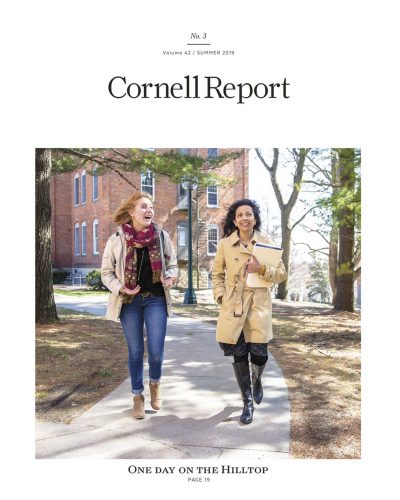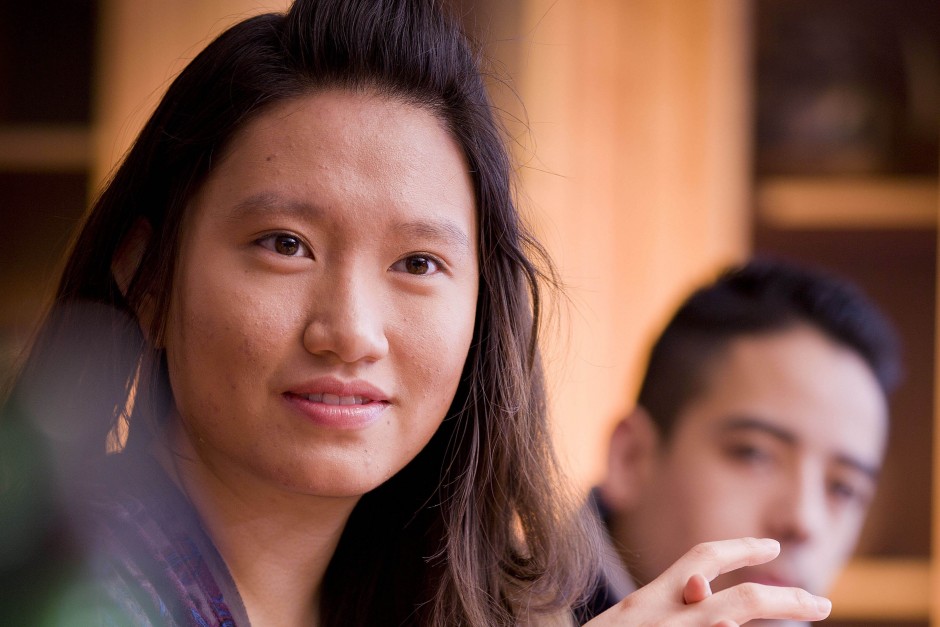
Diversity: Why it matters
 "I loved the campus. Mount Vernon is just a pleasant atmosphere, especially in spring and fall." The season in between? "That's something I'll never get used to," she said, laughing.
As an African-American woman from the South, Harris' leap into life at Cornell has been not unlike a tour of seasons: hot, cold, blustery, balmy. There's her accent. "I'm still learning to deal with people who don't understand me," she said, "but that's life."
There's less ethnic food than she's used to. There are classes she's loved, infused with thought-provoking multicultural lessons. And there have been classes for which she looked forward to sharing her unique cultural perspective, but race was only briefly discussed
As Cornell's student population reaches record levels in diversity, cultural assumptions are being pondered daily, a process that is fundamental to a liberal arts education.
"Diversity promotes critical thinking," said Tori Barnes-Brus '97, an assistant professor in Cornell's department of sociology and anthropology. "We expand our knowledge base when presented with differing viewpoints, or with accounts of different experiences, whether by students or faculty who are different, or by course materials that investigate diversity, inequality, and power. This allows us to understand things from multiple viewpoints, to weigh decisions based on experiences and situations that might differ from our own."
The value of these lessons has not been lost on Harris. In her journey through Cornell she's encountered ignorance and apathy, but also empathy and enlightenment. "I would not trade this experience for the world. Because of it, I'm a totally different person," said the senior.
That transformation goes two ways these days. Because of students like Harris, Cornell's student population is a melting pot with a medley of accents, international languages, life experiences, and wholly unique perspectives.
[caption id="attachment_17523" align="alignnone" width="750"]
"I loved the campus. Mount Vernon is just a pleasant atmosphere, especially in spring and fall." The season in between? "That's something I'll never get used to," she said, laughing.
As an African-American woman from the South, Harris' leap into life at Cornell has been not unlike a tour of seasons: hot, cold, blustery, balmy. There's her accent. "I'm still learning to deal with people who don't understand me," she said, "but that's life."
There's less ethnic food than she's used to. There are classes she's loved, infused with thought-provoking multicultural lessons. And there have been classes for which she looked forward to sharing her unique cultural perspective, but race was only briefly discussed
As Cornell's student population reaches record levels in diversity, cultural assumptions are being pondered daily, a process that is fundamental to a liberal arts education.
"Diversity promotes critical thinking," said Tori Barnes-Brus '97, an assistant professor in Cornell's department of sociology and anthropology. "We expand our knowledge base when presented with differing viewpoints, or with accounts of different experiences, whether by students or faculty who are different, or by course materials that investigate diversity, inequality, and power. This allows us to understand things from multiple viewpoints, to weigh decisions based on experiences and situations that might differ from our own."
The value of these lessons has not been lost on Harris. In her journey through Cornell she's encountered ignorance and apathy, but also empathy and enlightenment. "I would not trade this experience for the world. Because of it, I'm a totally different person," said the senior.
That transformation goes two ways these days. Because of students like Harris, Cornell's student population is a melting pot with a medley of accents, international languages, life experiences, and wholly unique perspectives.
[caption id="attachment_17523" align="alignnone" width="750"] (Photo by Jason Jones)[/caption]
(Photo by Jason Jones)[/caption]
Record diversity
This fall Cornell welcomed its most diverse class ever—about 25 percent students of color, including 6 percent from around the world, according to Jonathan Stroud, vice president for enrollment and dean of admission. The college's entire student population represents 47 states and includes 19 percent U.S. students of color, as well as 6 percent international students from 15 countries. Cornell's numbers are comparable to the 2010 U.S. Census national average of 72.4 percent white, and much more diverse than Iowa's 2010 Census average of 91.3 percent white. Compare this to 2002. Then, Cornell's diversity stood at 6 to 7 percent students of color, with a 1 percent international student population. "That was too homogenous," Stroud said. "We wanted to reflect the national population." To cast a still-selective but much wider net, Cornell teamed up with organizations like the Schuler Scholar Program. The organization, based in Lake Forest, Ill., helps under-resourced and high potential students—most first-generation college bound—prep for college academically and financially. "It's important because our graduates go into a world that is vastly different from even a few years ago," said Joe Dieker, dean of the college. "We're an increasingly diverse country and this country is playing an increasing role in the global community. That seems to be our future and we have to prepare our students for that future." What better way to make students worldly than to bring the world to their campus? And yet, bringing diverse populations to the Hilltop requires special considerations. For the first time, several families requested translators for parents at New Student Orientation this fall. And to ensure that issues of diversity are openly discussed, Ken Morris Jr., director of the Office of Intercultural Life, brought in Eddie Moore Jr. '89, a diversity consultant, founder of the White Privilege Conference, and director of diversity at Brooklyn Friends School, Brooklyn, N.Y., for training with the Class of 2015. "America—and Iowa—is changing. The question is: Are we ready?" Moore asked. "As for Cornell specifically, the campus community is changing. In order for Cornell to continue being a top-tier liberal arts college it must have the ability, skills, and resources needed to produce culturally competent and culturally confident students and future leaders. They have an opportunity to be one of the leaders in the state for tackling the issues of diversity, privilege and leadership. "My call to all Cornellians is this: We must challenge our youth from different identities, perspectives, experiences, communities and religious/non-religious backgrounds to find commonalities, possibilities and connections within issues of diversity, privilege, and leadership. Most importantly, they must develop the skills to be culturally competent and culturally confident." [caption id="attachment_17533" align="alignnone" width="683"]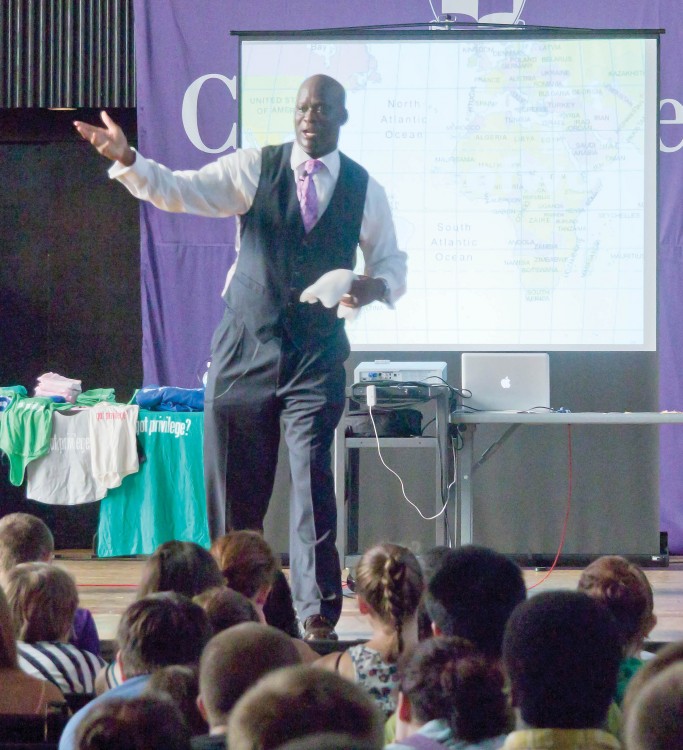 To help ensure that issues of diversity are discussed openly on campus, diversity consultant Eddie Moore Jr. '80 spoke at New Student Orientation in August (Photo by Nicole Potter '14)[/caption]
To help ensure that issues of diversity are discussed openly on campus, diversity consultant Eddie Moore Jr. '80 spoke at New Student Orientation in August (Photo by Nicole Potter '14)[/caption]
Numbers are significant
Programming like that wasn't part of the culture when Madgetta Thornton Dungy '64 arrived on campus .As the first African-American woman to graduate from Cornell, she was also the only African-American female student on campus during her first two years. She made lifelong female friends. But there were effectively no men on campus for her to date, and in the classroom, her young professors, all white and mostly male, "simply did not understand how to support me," she said. She sums up her experience at Cornell with one word: lonely. "The numbers are very, very significant both to the white students, as well as the students of color. It makes for such a rich and varied experience for everyone involved. It really should stimulate learning," she said of the incoming class' diversity. Dungy went on to earn a master's degree and a Ph.D., working in administration at six colleges and universities before retiring in 2005 as an assistant dean in the University of Iowa College of Medicine. At each academic stop, she saw the difference a nurturing environment and an openness to other ways of thinking can make for students of color. Getting a diverse group of students to Cornell is one thing, noted Dungy, a former Cornell trustee. How well Cornell helps these students feel comfortable and accepted in their new home is another. Getting the students involved and empowered in campus life is vital for retention. Retention at Cornell is 89.8 percent for students of color vs. 90.7 percent for the overall student population, according to Heidi Levine, dean of students. Cornell's Office of Intercultural Life (ICL) in Stoner House is key to keeping that rate solid. Junior Laura Sanchez came from Tucson, Ariz., for a campus visit and was excited by what she saw. "This is where I belong," she remembers thinking. But before long she was homesick. In Tucson, Latinos were the majority, she said, and "I never fully noticed I was different." At Cornell she was a minority and felt "different from everyone else." She made plans to transfer. But she was encouraged to explore ICL and became involved in the Organization for Latino Awareness. Sanchez started to feel at home. Encouraged to do something productive with her cultural background and her experiences, Sanchez has actively educated the campus about her Latino background, and is hoping to add a multicultural social club to campus. "I feel like now I am a somebody," she said. Acting as home away from home for all Cornell students, ICL especially offers to help students address cultural concerns and is a hub for programming and advocacy. ICL serves an eclectic group under the umbrella of diversity: African-Americans and Hispanic/Latinos, American Indians, Alaska Natives, Asian/Pacific Islanders and multiracial students. In addition, diversity at Cornell is also cultivated, although not tracked, in terms of socioeconomic background, sexual orientation, religion, gender, political views, etc. In short, "All marginalized groups, or historically underrepresented groups," explained Morris. Morris' job duties are equally varied, all with the goal of "building a campus that accepts, appreciates, and values all." From ICL comes special programming of all types, and conversations about hot button ultural issues. He helps students find resources they need to support and affirm their identities, such as places of worship, barbers and hair stylists, ethnic grocery stores and restaurants, conferences and workshops, scholarships, grants, and internships. He also investigates and translates cultural misunderstandings. Not long ago a panicked international student came to Morris for help. Working as a food service worker, the student had been chided for not wearing a hair net and warned she could be "sent home." To the student, here on a visa, that meant being booted from the United States. Morris stepped in, to explain and educate, on both sides. [caption id="attachment_17519" align="alignnone" width="750"]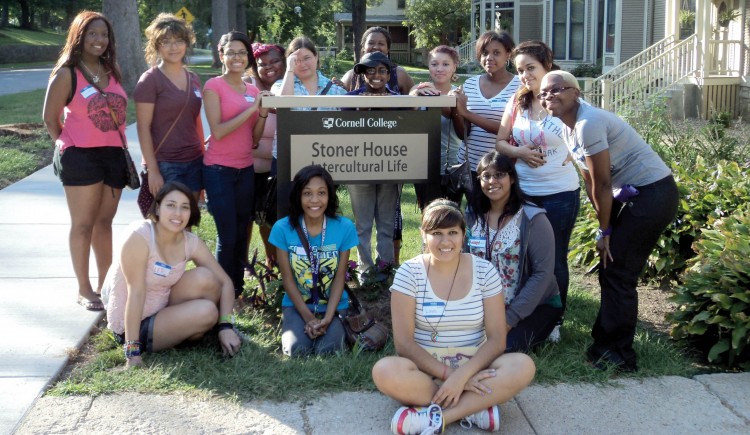 Several first-year students and mentors in the Students of Color Orientation congregate at Stoner House headquarters for the Office of Intercultural Life. (Photo by Ken Morris)[/caption]
Several first-year students and mentors in the Students of Color Orientation congregate at Stoner House headquarters for the Office of Intercultural Life. (Photo by Ken Morris)[/caption]
Systemic change
Morris works closely with the Council on Multiculturalism, which hopes to launch an in-depth study this year of campus climate to ferret out incidents of sexism, racism, and homophobia—malicious acts that are sometimes reported, but sometimes not. To do so will require some change for a long-established campus group. The council was created in the late 1990s specifically to promote diversity programming on campus. It has no official status with the college and so has limited ability to examine diversity-related issues and make official recommendations for action. With Cornell's demographics expanding, the council hopes this school year to graduate to a fully chartered status with the new name Diversity Committee. As proposed, this change would give the committee broad representation from the campus population and create a clear and unified statement about diversity, with an explanation of how it fits into the core values of Cornell. With this charter, the Diversity Committee would have more official power to assess programs, to investigate incidents of discrimination, and to study and make recommendations for recruiting a more diverse faculty and staff. Approved by President Jonathan Brand, the proposal goes to the faculty for approval this fall. Meanwhile, ICL is a resource for all Cornell students—black, white, brown, freckled, or foreign born. Senior Annie Schneider (representing the freckled population) came from Colorado Springs with a keen interest in social justice and became an ICL regular. "My involvement with ICL was integral to the learning and activism I've done at Cornell," said Schneider. ICL connected her to groups and other activists on campus. "Most of all, Ken and ICL helped me to understand my own privilege in a non-confrontational manner," she said. "Thinking about race shouldn't be scary or confrontational but an everyday occurrence, because racial and cultural differences shape every interaction a student has on campus or in the world. When I came to campus, people started talking, people argued and shared ideas. That's why I love Cornell; I'm not the only person asking 'why?'" "College isn't just about career preparation in the traditional sense," she added. "For me it was much more about learning how to understand how I fit into the world and how to get along with and value those who are different from me." [caption id="attachment_17515" align="alignnone" width="750"]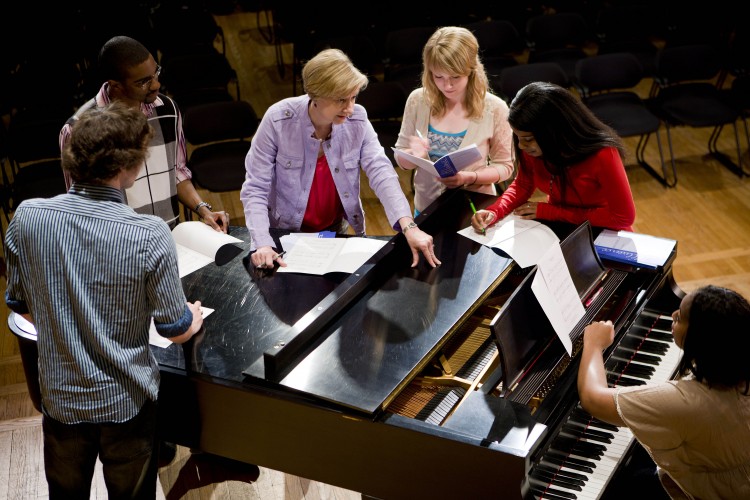 (Photo by Jason Jones)[/caption]
(Photo by Jason Jones)[/caption]
Cultural sampling
For students who choose to explore, opportunities for cultural sampling are endless, and the chance to see the world through a different lens, priceless. "It creates this richer environment," Levine said. "And for me that really goes to the heart of a liberal arts education, that it should be this opportunity for students to explore themselves, to explore the world, to really shape their knowledge base and their beliefs and their way of dealing with each other and dealing with the world, and taking that out with them when they graduate." Student Affairs encompasses ICL and is an active ally. This fall, for instance, the two offices launched a special orientation program for students of color. While ICL already pairs incoming minority and international students with peer mentors through a program called PALS (Prepare, Achieve, Learn, Succeed), student feedback indicated that more culturally-specific orientation would help. Now, international students and students of color receive a full day of orientation to give them a crash course on living in Iowa before other first-year students begin new student orientation. Junior Angie Rivera arrived in the foreign land of Cornell her freshman year with a rice cooker and a winter coat in her suitcase. The Hawaiian had never experienced a season other than summer. Her native language is Hawaiian Creole English and her diet staple, even in her high school cafeteria: sticky rice. She watched that fall unfold with fascination, and dug into Cornell life with the help of her PALS mentor, her Connect Floor friends, and the culinary kinship she developed with her Vietnamese roommate. The first time snow fell she watched solemnly through a window, delaying heading into the flakes for as long as possible. She and a fellow West Coast friend feared "ending up as popsicles under the snow and coming out in the spring," Rivera recalled. When asked why she left Hawaii for Iowa—and she is asked often—Rivera said it was affordability, One Course At A Time, and the quiet of a small college town. "And I tell them," she said, "if I could survive a Midwest winter then I could handle anything." In Cultural Anthropology and Ethnic Studies classes, though, she found another kind of cold front. "I learned just how ignorant some people were of other cultures and ethnicities," Rivera said. "One example happened in my Cultural Anthropology class. Our professor was discussing the Native Americans and how they had contracted small pox. When she asked the class how this happened, one student threw both his hands up and said 'We did!' Obviously this student was Caucasian, as was the majority of the class, who laughed," Rivera said. In response Rivera created Ná Keiki O Ka 'A'ali'i, an organization designed "to educate the campus and community about Hawaii's culture, and the cultural barriers which students from Hawaii encounter." Diversity in the classroom will only continue to help students develop a more complex worldview, said Barnes-Brus. "It can also be difficult, as students work not to reinforce stereotypes of others, as they cautiously listen to their peers, and as they try to make sense of how their perception of diversity shapes the way they interpret the materials in front of them." The number of courses incorporating race and ethnic studies has risen in tandem with each year's increase in multicultural students in Cornell's classrooms. So has the number of female professors at Cornell, closing a gender gap that was noted in an audit 10 years ago. [caption id="attachment_17517" align="alignnone" width="750"]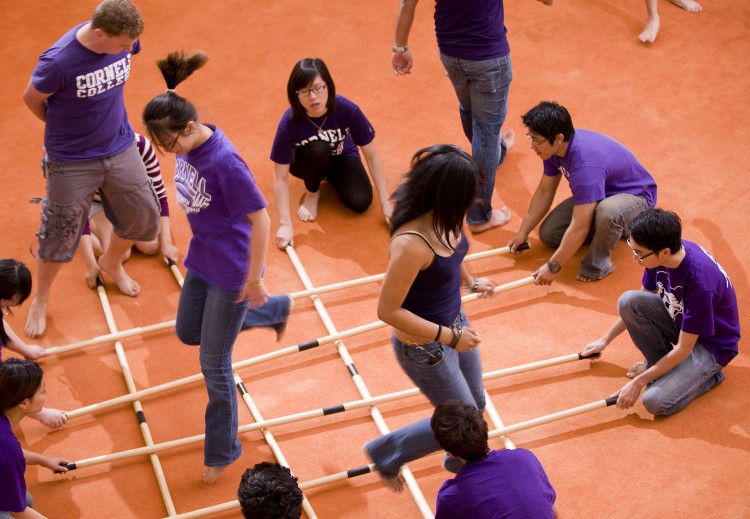 Members of the student group Eyes of the World perform a Bamboo dance on the Orange Carpet. (Photo by Jason Jones)[/caption]
Members of the student group Eyes of the World perform a Bamboo dance on the Orange Carpet. (Photo by Jason Jones)[/caption]
Gaps remain
Ethnic diversity among faculty is yet another way colleges can enhance a minority-friendly climate. Here, a gap has yet to be filled. "That's been a real challenge," said Dieker, who as dean of faculty is in charge of recruiting new professors. Cornell's faculty in 2010–11 was 94 percent white. Of the 36 full professors, just two are "faculty of color." "Seeing more African-American faculty would be beneficial," said Claire Solak, an African-American from suburban Denver whose high school was mostly white, and who jokes, "I came to rural Iowa and got my cultural experience." According to Dieker, the challenge is this: Cornell seeks only the most qualified of candidates for its academic positions. The number of qualified minority candidates still lags behind and those candidates are pursued by larger schools with more attractive compensation and, often, a more diverse community. In the past year Cornell has made changes to the way it recruits, changing language, for instance, in its postings. "But obviously," Dieker said, "it's an ongoing goal." Morris would like to see the college be more intentional about bringing in faculty and staff of color. "We shouldn't be content with the notion that people won't come here because we are a rural community," he said. And, as the college increases the number of students of color, he asks, "Where are our goals for inclusion? And then what are we doing to sustain this? Will this be Ken's agenda solely or will it continue under someone else's leadership someday?" In the working world, the safety net of ICL won't exist. There, Cornell alumni see how the college experience with diversity has real-world application. "Diversity is not as much about counting people as it is about making people count," said Cornell trustee Steve C. Anderson '75, president and CEO of the National Association of Chain Drug Stores, Alexandria, Va. "While demographic statistics provide important measures of progress, the benefits of multiculturalism really flourish when an organization commits to building true cultural intelligence. That means making it a priority to engage each member of a diverse team, empowering unique perspectives to create a more vibrant and varied environment, and as a result a better end-product. "I see these strategies produce extraordinary results within organizations and across industries. The continued focus on weaving diversity into the fabric of a Cornell College education will build ever-stronger students and an ever-stronger institution of higher learning." Asked to assess Cornell's environment, from the point of view of his years as a student, a staff member, and returning to campus for programming, diversity consultant Moore said the college is gaining ground. "Brother Ken Morris' work as director of intercultural life continues to provide excellent diversity programming, including bringing me back as an alum. Additionally, he has supported the White Privilege Conference by sending students over the years. Ken's work, to me, is a strong positive signal about Cornell's commitment to addressing issues of diversity, privilege, and leadership at the college. They aren't there yet, but the work is happening and that makes me very proud to call myself a Cornell College alum." Morris, "five years and countless stories" into his job, sees no room for complacency in his mission. "I'm excited to come to work because we're making progress," Morris said. "And yet it's not perfect and we're not happy with that either. I want to help make Cornell a more progressive institution and live out our mission." In his vision of a perfect world, there would be no Office of Intercultural Life. In that world, diversity would be fully interwoven into campus life, Morris said. In that place there would no longer be "Ken's students." Instead, they would fall under one label: "Cornell's students." Why is diversity important in college? Cornell sociology professor Tori Barnes-Brus '97 recommends an article published online on Aug. 12, 2009, in U.S. News & World Report by Aaron Thompson, coauthor with Joe Cuseo of Diversity and the College Experience. In short, these are his reasons:- Diversity expands worldliness.
- Diversity enhances social development.
- Diversity prepares students for future career success.
- Diversity prepares students for work in a global society.
- Interactions with people different from ourselves increase our knowledge base.
- Diversity promotes creative thinking.
- Diversity enhances self-awareness.
- Diversity enriches the multiple perspectives developed by a liberal arts education.
 "I loved the campus. Mount Vernon is just a pleasant atmosphere, especially in spring and fall." The season in between? "That's something I'll never get used to," she said, laughing.
As an African-American woman from the South, Harris' leap into life at Cornell has been not unlike a tour of seasons: hot, cold, blustery, balmy. There's her accent. "I'm still learning to deal with people who don't understand me," she said, "but that's life."
There's less ethnic food than she's used to. There are classes she's loved, infused with thought-provoking multicultural lessons. And there have been classes for which she looked forward to sharing her unique cultural perspective, but race was only briefly discussed
As Cornell's student population reaches record levels in diversity, cultural assumptions are being pondered daily, a process that is fundamental to a liberal arts education.
"Diversity promotes critical thinking," said Tori Barnes-Brus '97, an assistant professor in Cornell's department of sociology and anthropology. "We expand our knowledge base when presented with differing viewpoints, or with accounts of different experiences, whether by students or faculty who are different, or by course materials that investigate diversity, inequality, and power. This allows us to understand things from multiple viewpoints, to weigh decisions based on experiences and situations that might differ from our own."
The value of these lessons has not been lost on Harris. In her journey through Cornell she's encountered ignorance and apathy, but also empathy and enlightenment. "I would not trade this experience for the world. Because of it, I'm a totally different person," said the senior.
That transformation goes two ways these days. Because of students like Harris, Cornell's student population is a melting pot with a medley of accents, international languages, life experiences, and wholly unique perspectives.
[caption id="attachment_17523" align="alignnone" width="750"]
"I loved the campus. Mount Vernon is just a pleasant atmosphere, especially in spring and fall." The season in between? "That's something I'll never get used to," she said, laughing.
As an African-American woman from the South, Harris' leap into life at Cornell has been not unlike a tour of seasons: hot, cold, blustery, balmy. There's her accent. "I'm still learning to deal with people who don't understand me," she said, "but that's life."
There's less ethnic food than she's used to. There are classes she's loved, infused with thought-provoking multicultural lessons. And there have been classes for which she looked forward to sharing her unique cultural perspective, but race was only briefly discussed
As Cornell's student population reaches record levels in diversity, cultural assumptions are being pondered daily, a process that is fundamental to a liberal arts education.
"Diversity promotes critical thinking," said Tori Barnes-Brus '97, an assistant professor in Cornell's department of sociology and anthropology. "We expand our knowledge base when presented with differing viewpoints, or with accounts of different experiences, whether by students or faculty who are different, or by course materials that investigate diversity, inequality, and power. This allows us to understand things from multiple viewpoints, to weigh decisions based on experiences and situations that might differ from our own."
The value of these lessons has not been lost on Harris. In her journey through Cornell she's encountered ignorance and apathy, but also empathy and enlightenment. "I would not trade this experience for the world. Because of it, I'm a totally different person," said the senior.
That transformation goes two ways these days. Because of students like Harris, Cornell's student population is a melting pot with a medley of accents, international languages, life experiences, and wholly unique perspectives.
[caption id="attachment_17523" align="alignnone" width="750"] (Photo by Jason Jones)[/caption]
(Photo by Jason Jones)[/caption]
Record diversity
This fall Cornell welcomed its most diverse class ever—about 25 percent students of color, including 6 percent from around the world, according to Jonathan Stroud, vice president for enrollment and dean of admission. The college's entire student population represents 47 states and includes 19 percent U.S. students of color, as well as 6 percent international students from 15 countries. Cornell's numbers are comparable to the 2010 U.S. Census national average of 72.4 percent white, and much more diverse than Iowa's 2010 Census average of 91.3 percent white. Compare this to 2002. Then, Cornell's diversity stood at 6 to 7 percent students of color, with a 1 percent international student population. "That was too homogenous," Stroud said. "We wanted to reflect the national population." To cast a still-selective but much wider net, Cornell teamed up with organizations like the Schuler Scholar Program. The organization, based in Lake Forest, Ill., helps under-resourced and high potential students—most first-generation college bound—prep for college academically and financially. "It's important because our graduates go into a world that is vastly different from even a few years ago," said Joe Dieker, dean of the college. "We're an increasingly diverse country and this country is playing an increasing role in the global community. That seems to be our future and we have to prepare our students for that future." What better way to make students worldly than to bring the world to their campus? And yet, bringing diverse populations to the Hilltop requires special considerations. For the first time, several families requested translators for parents at New Student Orientation this fall. And to ensure that issues of diversity are openly discussed, Ken Morris Jr., director of the Office of Intercultural Life, brought in Eddie Moore Jr. '89, a diversity consultant, founder of the White Privilege Conference, and director of diversity at Brooklyn Friends School, Brooklyn, N.Y., for training with the Class of 2015. "America—and Iowa—is changing. The question is: Are we ready?" Moore asked. "As for Cornell specifically, the campus community is changing. In order for Cornell to continue being a top-tier liberal arts college it must have the ability, skills, and resources needed to produce culturally competent and culturally confident students and future leaders. They have an opportunity to be one of the leaders in the state for tackling the issues of diversity, privilege and leadership. "My call to all Cornellians is this: We must challenge our youth from different identities, perspectives, experiences, communities and religious/non-religious backgrounds to find commonalities, possibilities and connections within issues of diversity, privilege, and leadership. Most importantly, they must develop the skills to be culturally competent and culturally confident." [caption id="attachment_17533" align="alignnone" width="683"] To help ensure that issues of diversity are discussed openly on campus, diversity consultant Eddie Moore Jr. '80 spoke at New Student Orientation in August (Photo by Nicole Potter '14)[/caption]
To help ensure that issues of diversity are discussed openly on campus, diversity consultant Eddie Moore Jr. '80 spoke at New Student Orientation in August (Photo by Nicole Potter '14)[/caption]
Numbers are significant
Programming like that wasn't part of the culture when Madgetta Thornton Dungy '64 arrived on campus .As the first African-American woman to graduate from Cornell, she was also the only African-American female student on campus during her first two years. She made lifelong female friends. But there were effectively no men on campus for her to date, and in the classroom, her young professors, all white and mostly male, "simply did not understand how to support me," she said. She sums up her experience at Cornell with one word: lonely. "The numbers are very, very significant both to the white students, as well as the students of color. It makes for such a rich and varied experience for everyone involved. It really should stimulate learning," she said of the incoming class' diversity. Dungy went on to earn a master's degree and a Ph.D., working in administration at six colleges and universities before retiring in 2005 as an assistant dean in the University of Iowa College of Medicine. At each academic stop, she saw the difference a nurturing environment and an openness to other ways of thinking can make for students of color. Getting a diverse group of students to Cornell is one thing, noted Dungy, a former Cornell trustee. How well Cornell helps these students feel comfortable and accepted in their new home is another. Getting the students involved and empowered in campus life is vital for retention. Retention at Cornell is 89.8 percent for students of color vs. 90.7 percent for the overall student population, according to Heidi Levine, dean of students. Cornell's Office of Intercultural Life (ICL) in Stoner House is key to keeping that rate solid. Junior Laura Sanchez came from Tucson, Ariz., for a campus visit and was excited by what she saw. "This is where I belong," she remembers thinking. But before long she was homesick. In Tucson, Latinos were the majority, she said, and "I never fully noticed I was different." At Cornell she was a minority and felt "different from everyone else." She made plans to transfer. But she was encouraged to explore ICL and became involved in the Organization for Latino Awareness. Sanchez started to feel at home. Encouraged to do something productive with her cultural background and her experiences, Sanchez has actively educated the campus about her Latino background, and is hoping to add a multicultural social club to campus. "I feel like now I am a somebody," she said. Acting as home away from home for all Cornell students, ICL especially offers to help students address cultural concerns and is a hub for programming and advocacy. ICL serves an eclectic group under the umbrella of diversity: African-Americans and Hispanic/Latinos, American Indians, Alaska Natives, Asian/Pacific Islanders and multiracial students. In addition, diversity at Cornell is also cultivated, although not tracked, in terms of socioeconomic background, sexual orientation, religion, gender, political views, etc. In short, "All marginalized groups, or historically underrepresented groups," explained Morris. Morris' job duties are equally varied, all with the goal of "building a campus that accepts, appreciates, and values all." From ICL comes special programming of all types, and conversations about hot button ultural issues. He helps students find resources they need to support and affirm their identities, such as places of worship, barbers and hair stylists, ethnic grocery stores and restaurants, conferences and workshops, scholarships, grants, and internships. He also investigates and translates cultural misunderstandings. Not long ago a panicked international student came to Morris for help. Working as a food service worker, the student had been chided for not wearing a hair net and warned she could be "sent home." To the student, here on a visa, that meant being booted from the United States. Morris stepped in, to explain and educate, on both sides. [caption id="attachment_17519" align="alignnone" width="750"] Several first-year students and mentors in the Students of Color Orientation congregate at Stoner House headquarters for the Office of Intercultural Life. (Photo by Ken Morris)[/caption]
Several first-year students and mentors in the Students of Color Orientation congregate at Stoner House headquarters for the Office of Intercultural Life. (Photo by Ken Morris)[/caption]
Systemic change
Morris works closely with the Council on Multiculturalism, which hopes to launch an in-depth study this year of campus climate to ferret out incidents of sexism, racism, and homophobia—malicious acts that are sometimes reported, but sometimes not. To do so will require some change for a long-established campus group. The council was created in the late 1990s specifically to promote diversity programming on campus. It has no official status with the college and so has limited ability to examine diversity-related issues and make official recommendations for action. With Cornell's demographics expanding, the council hopes this school year to graduate to a fully chartered status with the new name Diversity Committee. As proposed, this change would give the committee broad representation from the campus population and create a clear and unified statement about diversity, with an explanation of how it fits into the core values of Cornell. With this charter, the Diversity Committee would have more official power to assess programs, to investigate incidents of discrimination, and to study and make recommendations for recruiting a more diverse faculty and staff. Approved by President Jonathan Brand, the proposal goes to the faculty for approval this fall. Meanwhile, ICL is a resource for all Cornell students—black, white, brown, freckled, or foreign born. Senior Annie Schneider (representing the freckled population) came from Colorado Springs with a keen interest in social justice and became an ICL regular. "My involvement with ICL was integral to the learning and activism I've done at Cornell," said Schneider. ICL connected her to groups and other activists on campus. "Most of all, Ken and ICL helped me to understand my own privilege in a non-confrontational manner," she said. "Thinking about race shouldn't be scary or confrontational but an everyday occurrence, because racial and cultural differences shape every interaction a student has on campus or in the world. When I came to campus, people started talking, people argued and shared ideas. That's why I love Cornell; I'm not the only person asking 'why?'" "College isn't just about career preparation in the traditional sense," she added. "For me it was much more about learning how to understand how I fit into the world and how to get along with and value those who are different from me." [caption id="attachment_17515" align="alignnone" width="750"] (Photo by Jason Jones)[/caption]
(Photo by Jason Jones)[/caption]
Cultural sampling
For students who choose to explore, opportunities for cultural sampling are endless, and the chance to see the world through a different lens, priceless. "It creates this richer environment," Levine said. "And for me that really goes to the heart of a liberal arts education, that it should be this opportunity for students to explore themselves, to explore the world, to really shape their knowledge base and their beliefs and their way of dealing with each other and dealing with the world, and taking that out with them when they graduate." Student Affairs encompasses ICL and is an active ally. This fall, for instance, the two offices launched a special orientation program for students of color. While ICL already pairs incoming minority and international students with peer mentors through a program called PALS (Prepare, Achieve, Learn, Succeed), student feedback indicated that more culturally-specific orientation would help. Now, international students and students of color receive a full day of orientation to give them a crash course on living in Iowa before other first-year students begin new student orientation. Junior Angie Rivera arrived in the foreign land of Cornell her freshman year with a rice cooker and a winter coat in her suitcase. The Hawaiian had never experienced a season other than summer. Her native language is Hawaiian Creole English and her diet staple, even in her high school cafeteria: sticky rice. She watched that fall unfold with fascination, and dug into Cornell life with the help of her PALS mentor, her Connect Floor friends, and the culinary kinship she developed with her Vietnamese roommate. The first time snow fell she watched solemnly through a window, delaying heading into the flakes for as long as possible. She and a fellow West Coast friend feared "ending up as popsicles under the snow and coming out in the spring," Rivera recalled. When asked why she left Hawaii for Iowa—and she is asked often—Rivera said it was affordability, One Course At A Time, and the quiet of a small college town. "And I tell them," she said, "if I could survive a Midwest winter then I could handle anything." In Cultural Anthropology and Ethnic Studies classes, though, she found another kind of cold front. "I learned just how ignorant some people were of other cultures and ethnicities," Rivera said. "One example happened in my Cultural Anthropology class. Our professor was discussing the Native Americans and how they had contracted small pox. When she asked the class how this happened, one student threw both his hands up and said 'We did!' Obviously this student was Caucasian, as was the majority of the class, who laughed," Rivera said. In response Rivera created Ná Keiki O Ka 'A'ali'i, an organization designed "to educate the campus and community about Hawaii's culture, and the cultural barriers which students from Hawaii encounter." Diversity in the classroom will only continue to help students develop a more complex worldview, said Barnes-Brus. "It can also be difficult, as students work not to reinforce stereotypes of others, as they cautiously listen to their peers, and as they try to make sense of how their perception of diversity shapes the way they interpret the materials in front of them." The number of courses incorporating race and ethnic studies has risen in tandem with each year's increase in multicultural students in Cornell's classrooms. So has the number of female professors at Cornell, closing a gender gap that was noted in an audit 10 years ago. [caption id="attachment_17517" align="alignnone" width="750"] Members of the student group Eyes of the World perform a Bamboo dance on the Orange Carpet. (Photo by Jason Jones)[/caption]
Members of the student group Eyes of the World perform a Bamboo dance on the Orange Carpet. (Photo by Jason Jones)[/caption]
Gaps remain
Ethnic diversity among faculty is yet another way colleges can enhance a minority-friendly climate. Here, a gap has yet to be filled. "That's been a real challenge," said Dieker, who as dean of faculty is in charge of recruiting new professors. Cornell's faculty in 2010–11 was 94 percent white. Of the 36 full professors, just two are "faculty of color." "Seeing more African-American faculty would be beneficial," said Claire Solak, an African-American from suburban Denver whose high school was mostly white, and who jokes, "I came to rural Iowa and got my cultural experience." According to Dieker, the challenge is this: Cornell seeks only the most qualified of candidates for its academic positions. The number of qualified minority candidates still lags behind and those candidates are pursued by larger schools with more attractive compensation and, often, a more diverse community. In the past year Cornell has made changes to the way it recruits, changing language, for instance, in its postings. "But obviously," Dieker said, "it's an ongoing goal." Morris would like to see the college be more intentional about bringing in faculty and staff of color. "We shouldn't be content with the notion that people won't come here because we are a rural community," he said. And, as the college increases the number of students of color, he asks, "Where are our goals for inclusion? And then what are we doing to sustain this? Will this be Ken's agenda solely or will it continue under someone else's leadership someday?" In the working world, the safety net of ICL won't exist. There, Cornell alumni see how the college experience with diversity has real-world application. "Diversity is not as much about counting people as it is about making people count," said Cornell trustee Steve C. Anderson '75, president and CEO of the National Association of Chain Drug Stores, Alexandria, Va. "While demographic statistics provide important measures of progress, the benefits of multiculturalism really flourish when an organization commits to building true cultural intelligence. That means making it a priority to engage each member of a diverse team, empowering unique perspectives to create a more vibrant and varied environment, and as a result a better end-product. "I see these strategies produce extraordinary results within organizations and across industries. The continued focus on weaving diversity into the fabric of a Cornell College education will build ever-stronger students and an ever-stronger institution of higher learning." Asked to assess Cornell's environment, from the point of view of his years as a student, a staff member, and returning to campus for programming, diversity consultant Moore said the college is gaining ground. "Brother Ken Morris' work as director of intercultural life continues to provide excellent diversity programming, including bringing me back as an alum. Additionally, he has supported the White Privilege Conference by sending students over the years. Ken's work, to me, is a strong positive signal about Cornell's commitment to addressing issues of diversity, privilege, and leadership at the college. They aren't there yet, but the work is happening and that makes me very proud to call myself a Cornell College alum." Morris, "five years and countless stories" into his job, sees no room for complacency in his mission. "I'm excited to come to work because we're making progress," Morris said. "And yet it's not perfect and we're not happy with that either. I want to help make Cornell a more progressive institution and live out our mission." In his vision of a perfect world, there would be no Office of Intercultural Life. In that world, diversity would be fully interwoven into campus life, Morris said. In that place there would no longer be "Ken's students." Instead, they would fall under one label: "Cornell's students." Why is diversity important in college? Cornell sociology professor Tori Barnes-Brus '97 recommends an article published online on Aug. 12, 2009, in U.S. News & World Report by Aaron Thompson, coauthor with Joe Cuseo of Diversity and the College Experience. In short, these are his reasons:- Diversity expands worldliness.
- Diversity enhances social development.
- Diversity prepares students for future career success.
- Diversity prepares students for work in a global society.
- Interactions with people different from ourselves increase our knowledge base.
- Diversity promotes creative thinking.
- Diversity enhances self-awareness.
- Diversity enriches the multiple perspectives developed by a liberal arts education.
Ariel Harris was a high school student in Spring, Texas, when she met a college recruiter promoting a rigorous learning style that stood out to her

